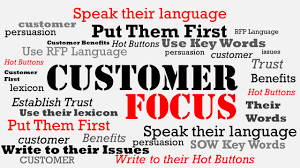It takes months to get a customer and seconds to lose- Vince Lombard
Introduction
A customer is the most important visitor on our premises. He is not dependent on us. We are dependent on him. He is not an interruption on our work. He is the purpose of it. He is not an outsider on our business. He is part of it. We are not doing him a favour by serving him. He is doing us a favour by giving us an opportunity to do so. ~ Mahatma Gandhi
Objective
The key objective is to understand the first principle of quality management, the needs and expectations of the customer, how to meet and exceed the expectations. Different customers may have dissimilar needs and expectation, each has to be dealt as per them. Once done effectively, the organization can deserve its sweet fruits.
Definitions: ISO 9000: 2015
Customer (Cl 3.2.4): Person or organization that could or does receive a product or a service that is intended for or required by this person or organization. A customer can be internal or external to the organization.
Detailed Information
The quality Management Principles are not specific to any one industry and can be applied to organizations of any size.
As per ISO 9000: 2015, clause 2.3, following are the 7 principles of Quality Management
- Customer Focus
- Leadership
- Engagement of People
- Process Approach
- Improvement
- Evidence-based decision making
- Relationship Management
Customer Focus:
In any organization, the processes are interrelated and interact with each other. For consistent and predictable results for the customer, the internal processes should work in tandem with each other.
There are 3 key things which need to be focused (refer to IATF 16949:2016). They are
- customer and applicable statutory and regulatory requirements are determined, understood and consistently met:
- Understand customer current and future requirement (Drawing, specification, supplier manual) & Legal requirements (Euro VI, Electric Vehicle)
- implement customer requirement & Legal requirements
- Verify its effectiveness
- Improve it further
- the risks and opportunities that can affect the conformity of products and services and the ability to enhance customer satisfaction are determined and addressed:
- Different customer can have varied risks and opportunities (COVID-19, cash flow, Quality, Service)
- Identify risk and opportunity for each customer and relevant interested party
- Use a cross-functional team approach
- Take appropriate action to minimize or avoid the risk and seize the opportunity
- Periodically review the risk and opportunity as the business environment is complex and everchanging
- Implement the changes where needed
- the focus on enhancing customer satisfaction is maintained:
- Putting the customer first and identify key parameter relevant for each customer like quality, delivery, service, costing, response time etc.
- Make the customer feel heard by effective communication with the customer by getting confirmation from them if they are aligned with the parameters set by the organization
- Periodically review these parameters with top management
- Take actions where needed
- A transparent and warm relationship with all the relevant stakeholders is must for the sustained success of the organization.
What benefits the organization can achieve?
- Increased customer satisfaction and loyalty
- Repeat business
- Enhanced reputation
- Increased revenue and market share
- The consistent and predictable outcome
- Expanded customer base
Present Challenges:
- How often the organization is focused on understanding the needs and expectation of their customer?
- How often the decision is based on evidence and not on hunch feeling?
- How often analysis and actions are taken based on customer feedback (customer satisfaction survey, customer rating etc.)?
- How often the organization team is competent to understand and share the expected requirement of the customer with top management?
References:
ISO 9000: 2015
ISO 9001: 2015
IATF 16949: 2016
This is the 83rd article of this Quality Management series. Every weekend, you will find useful information that will make your Management System journey Productive. Please share it with your colleagues too.
Your genuine feedback and response are extremely valuable. Please suggest topics for the coming weeks.
